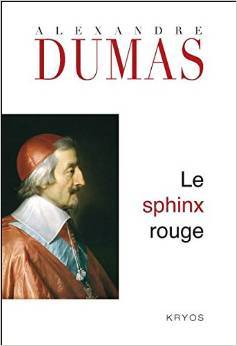Alexandre Dumas, born the grandson of a French nobleman and an African slave in Saint-Domingue (today Haiti) in 1802 and son of one of Napoleon’s officers in Italy and Egypt, accomplished a prodigious amount of work in his 68 years. So far as I know he never wrote a book of less than nearly a thousand pages, and I understand that unpublished works of his are still turning up. His most famous novels are The Count of Monte Cristo and The Three Musketeers, so when I read earlier this year of the publication in France of a sequel to the latter novel, I ordered a copy from the publisher (Kryos). In fact, Le sphinx rouge is a sequel in terms of historical time only, taking up after the lifting of the siege of La Rochelle in 1628, where Musketeers leaves off.
One hundred and forty-seven into 732 pages, my impression is of a book that is less an adventure story in the manner of its predecessors than a social portrait of France in the early part of the 17th century. The Red Sphinx, of course, is Cardinal Richelieu, portrayed by Dumas as the man who governed France and held her together between the assassination of Henry IV (“Paris is well worth a Mass”) by François Ravaillac and the accession to the throne of Louis XIV—during the reign of Louis XIII, described in the novel by his wife, Anne of Austria and sister of Phillip IV of Spain, as the “phantom king” who barely existed even as a human being, let alone as the French monarch. According to Dumas, Richelieu was in love (so far as I’ve read, chastely) with his young niece, Madame de Combalet, in 1628 his sole emotional support at a time when everyone in the French court (and many out of it), including the Queen and Marie de’ Medici, the Queen Mother, wished him dead and was prepared to act on that wish. Though Dumas’s story moves along at a rather sedate pace, the atmosphere of suppressed crisis he creates holds the reader’s (mine, at least) attention as he describes the social and intellectual life of the great aristocratic hôtels of Paris, which enthusiastically received the literary luminaries at the dawn of the classic period of French literature, including the young playwright Pierre Corneille, who appears early on in the story to read aloud passages from his latest work to Mme. de Rambouillet and her friends.
English readers of the French text will find Dumas’s prose in this novel more complex (at times downright careless) compared with the style he employed in his famous books, but perhaps the publishers have simplified it in translation. At any rate, this very informative and engaging example of historical fiction is well worth the expenditure of time it takes to get through it (whether in French or in English). Though not, of course, missing Mass.

Leave a Reply